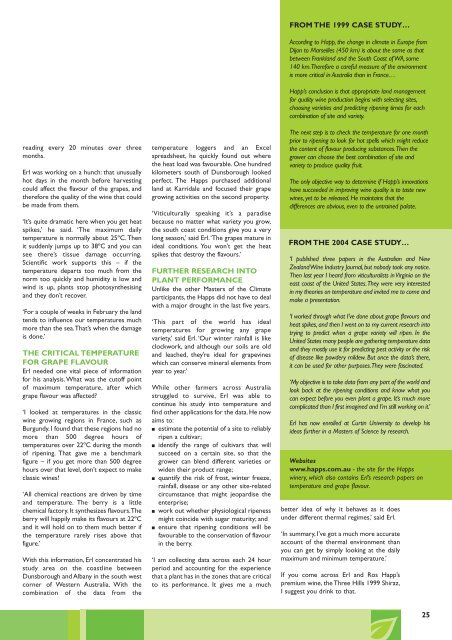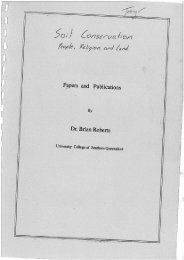Masters of the Climate: Innovative farmers ... - South West NRM
Masters of the Climate: Innovative farmers ... - South West NRM
Masters of the Climate: Innovative farmers ... - South West NRM
Create successful ePaper yourself
Turn your PDF publications into a flip-book with our unique Google optimized e-Paper software.
eading every 20 minutes over three<br />
months.<br />
Erl was working on a hunch: that unusually<br />
hot days in <strong>the</strong> month before harvesting<br />
could affect <strong>the</strong> flavour <strong>of</strong> <strong>the</strong> grapes, and<br />
<strong>the</strong>refore <strong>the</strong> quality <strong>of</strong> <strong>the</strong> wine that could<br />
be made from <strong>the</strong>m.<br />
‘It’s quite dramatic here when you get heat<br />
spikes,’ he said. ‘The maximum daily<br />
temperature is normally about 25ºC.Then<br />
it suddenly jumps up to 38ºC and you can<br />
see <strong>the</strong>re’s tissue damage occurring.<br />
Scientific work supports this – if <strong>the</strong><br />
temperature departs too much from <strong>the</strong><br />
norm too quickly and humidity is low and<br />
wind is up, plants stop photosyn<strong>the</strong>sising<br />
and <strong>the</strong>y don’t recover.<br />
‘For a couple <strong>of</strong> weeks in February <strong>the</strong> land<br />
tends to influence our temperatures much<br />
more than <strong>the</strong> sea.That’s when <strong>the</strong> damage<br />
is done.’<br />
THE CRITICAL TEMPERATURE<br />
FOR GRAPE FLAVOUR<br />
Erl needed one vital piece <strong>of</strong> information<br />
for his analysis. What was <strong>the</strong> cut<strong>of</strong>f point<br />
<strong>of</strong> maximum temperature, after which<br />
grape flavour was affected?<br />
‘I looked at temperatures in <strong>the</strong> classic<br />
wine growing regions in France, such as<br />
Burgundy. I found that <strong>the</strong>se regions had no<br />
more than 500 degree hours <strong>of</strong><br />
temperatures over 22ºC during <strong>the</strong> month<br />
<strong>of</strong> ripening. That gave me a benchmark<br />
figure – if you get more than 500 degree<br />
hours over that level, don’t expect to make<br />
classic wines!<br />
‘All chemical reactions are driven by time<br />
and temperature. The berry is a little<br />
chemical factory. It syn<strong>the</strong>sizes flavours.The<br />
berry will happily make its flavours at 22ºC<br />
and it will hold on to <strong>the</strong>m much better if<br />
<strong>the</strong> temperature rarely rises above that<br />
figure.’<br />
With this information, Erl concentrated his<br />
study area on <strong>the</strong> coastline between<br />
Dunsborough and Albany in <strong>the</strong> south west<br />
corner <strong>of</strong> <strong>West</strong>ern Australia. With <strong>the</strong><br />
combination <strong>of</strong> <strong>the</strong> data from <strong>the</strong><br />
temperature loggers and an Excel<br />
spreadsheet, he quickly found out where<br />
<strong>the</strong> heat load was favourable. One hundred<br />
kilometers south <strong>of</strong> Dunsborough looked<br />
perfect. The Happs purchased additional<br />
land at Karridale and focused <strong>the</strong>ir grape<br />
growing activities on <strong>the</strong> second property.<br />
‘Viticulturally speaking it’s a paradise<br />
because no matter what variety you grow,<br />
<strong>the</strong> south coast conditions give you a very<br />
long season,’ said Erl.‘The grapes mature in<br />
ideal conditions. You won’t get <strong>the</strong> heat<br />
spikes that destroy <strong>the</strong> flavours.’<br />
FURTHER RESEARCH INTO<br />
PLANT PERFORMANCE<br />
Unlike <strong>the</strong> o<strong>the</strong>r <strong>Masters</strong> <strong>of</strong> <strong>the</strong> <strong>Climate</strong><br />
participants, <strong>the</strong> Happs did not have to deal<br />
with a major drought in <strong>the</strong> last five years.<br />
‘This part <strong>of</strong> <strong>the</strong> world has ideal<br />
temperatures for growing any grape<br />
variety,’ said Erl. ‘Our winter rainfall is like<br />
clockwork, and although our soils are old<br />
and leached, <strong>the</strong>y’re ideal for grapevines<br />
which can conserve mineral elements from<br />
year to year.’<br />
While o<strong>the</strong>r <strong>farmers</strong> across Australia<br />
struggled to survive, Erl was able to<br />
continue his study into temperature and<br />
find o<strong>the</strong>r applications for <strong>the</strong> data. He now<br />
aims to:<br />
estimate <strong>the</strong> potential <strong>of</strong> a site to reliably<br />
ripen a cultivar;<br />
identify <strong>the</strong> range <strong>of</strong> cultivars that will<br />
succeed on a certain site, so that <strong>the</strong><br />
grower can blend different varieties or<br />
widen <strong>the</strong>ir product range;<br />
quantify <strong>the</strong> risk <strong>of</strong> frost, winter freeze,<br />
rainfall, disease or any o<strong>the</strong>r site-related<br />
circumstance that might jeopardise <strong>the</strong><br />
enterprise;<br />
work out whe<strong>the</strong>r physiological ripeness<br />
might coincide with sugar maturity; and<br />
ensure that ripening conditions will be<br />
favourable to <strong>the</strong> conservation <strong>of</strong> flavour<br />
in <strong>the</strong> berry.<br />
‘I am collecting data across each 24 hour<br />
period and accounting for <strong>the</strong> experience<br />
that a plant has in <strong>the</strong> zones that are critical<br />
to its performance. It gives me a much<br />
FROM THE 1999 CASE STUDY…<br />
According to Happ, <strong>the</strong> change in climate in Europe from<br />
Dijon to Marseilles (450 km) is about <strong>the</strong> same as that<br />
between Frankland and <strong>the</strong> <strong>South</strong> Coast <strong>of</strong> WA, some<br />
140 km.Therefore a careful measure <strong>of</strong> <strong>the</strong> environment<br />
is more critical in Australia than in France…<br />
Happ’s conclusion is that appropriate land management<br />
for quality wine production begins with selecting sites,<br />
choosing varieties and predicting ripening times for each<br />
combination <strong>of</strong> site and variety.<br />
The next step is to check <strong>the</strong> temperature for one month<br />
prior to ripening to look for hot spells which might reduce<br />
<strong>the</strong> content <strong>of</strong> flavour producing substances.Then <strong>the</strong><br />
grower can choose <strong>the</strong> best combination <strong>of</strong> site and<br />
variety to produce quality fruit.<br />
The only objective way to determine if Happ’s innovations<br />
have succeeded in improving wine quality is to taste new<br />
wines, yet to be released. He maintains that <strong>the</strong><br />
differences are obvious, even to <strong>the</strong> untrained palate.<br />
FROM THE 2004 CASE STUDY…<br />
‘I published three papers in <strong>the</strong> Australian and New<br />
Zealand Wine Industry Journal,but nobody took any notice.<br />
Then last year I heard from viticulturalists in Virginia on <strong>the</strong><br />
east coast <strong>of</strong> <strong>the</strong> United States.They were very interested<br />
in my <strong>the</strong>ories on temperature and invited me to come and<br />
make a presentation.<br />
‘I worked through what I’ve done about grape flavours and<br />
heat spikes, and <strong>the</strong>n I went on to my current research into<br />
trying to predict when a grape variety will ripen. In <strong>the</strong><br />
United States many people are ga<strong>the</strong>ring temperature data<br />
and <strong>the</strong>y mostly use it for predicting pest activity or <strong>the</strong> risk<br />
<strong>of</strong> disease like powdery mildew. But once <strong>the</strong> data’s <strong>the</strong>re,<br />
it can be used for o<strong>the</strong>r purposes.They were fascinated.<br />
‘My objective is to take data from any part <strong>of</strong> <strong>the</strong> world and<br />
look back at <strong>the</strong> ripening conditions and know what you<br />
can expect before you even plant a grape. It’s much more<br />
complicated than I first imagined and I’m still working on it.’<br />
Erl has now enrolled at Curtin University to develop his<br />
ideas fur<strong>the</strong>r in a <strong>Masters</strong> <strong>of</strong> Science by research.<br />
Websites<br />
www.happs.com.au - <strong>the</strong> site for <strong>the</strong> Happs<br />
winery, which also contains Erl’s research papers on<br />
temperature and grape flavour.<br />
better idea <strong>of</strong> why it behaves as it does<br />
under different <strong>the</strong>rmal regimes,’ said Erl.<br />
‘In summary, I’ve got a much more accurate<br />
account <strong>of</strong> <strong>the</strong> <strong>the</strong>rmal environment than<br />
you can get by simply looking at <strong>the</strong> daily<br />
maximum and minimum temperature.’<br />
If you come across Erl and Ros Happ’s<br />
premium wine, <strong>the</strong> Three Hills 1999 Shiraz,<br />
I suggest you drink to that.<br />
25
















